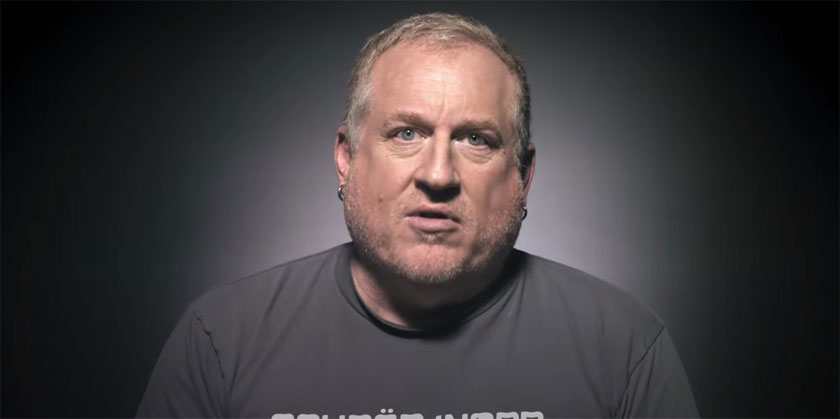Power On: The 20th Anniversary Documentary of the Xbox

I vaguely remember one school morning when I, a pimple-faced freshman in high school, met up with one of my closest friends for our usual round of pre-homeroom chatter. With a mocking grin on his face, he informed me that Microsoft was making a “Direct X Box”, a brand new console to compete with Sony and Nintendo. His laughter and dismissal were understandable at the time, for conventional wisdom held that, much like political parties, no third system could possibly survive. We had watched as the Atari Jaguar went extinct, were barely familiar with the existence of the 3DO before it crashed and burned, had witnessed the SEGA Saturn barely make a name for itself next to the N64 and Sony PlayStation, and were mourning the inevitable demise of SEGA as a console manufacturer. The Dreamcast was failing to make a dent in the market while all eyes were on the PlayStation 2 and upcoming Nintendo Dolphin. Your best bet was to dethrone one of the top dogs just as Sony had done against SEGA, and there was no foreseeable way that Microsoft could kick either Sony or Nintendo to the curb.
This was nothing to say of Microsoft’s reputation at the time. We were in the middle of the disastrous Windows ME, perhaps the most buggy and crash-happy operating system I’ve still ever used in my life. You were more fortunate to be running Windows 2000 instead, though it, too, fell victim to the dreaded Blue Screen of Death on a fairly regular basis. For a bunch of young punk teens that were witness to the birth of the Internet age, however, we were also becoming increasingly aware of the limitations and inconvenience of Microsoft’s proprietary measures. MS Paint was vastly inferior to any other image editing program, be they free like GIMP or more costly like Adobe Photoshop and its affordable Elements line. Windows Media Player was an unnecessarily large application both in screen real estate and resources, swiftly replaced by the likes of Winamp for music by most. This was not long after Microsoft was taken to trial for an attempted monopoly by bundling their Office software, and were effectively seen as an evil, world consuming empire of gluttonous greed.
Nonetheless, I shrugged my shoulders and told my friend I’d wait and see what they did. We still did not have enough information on what the system would look like, how it would differentiate itself, and what games would be on it, and until Sony came along with the PlayStation no one expected SEGA to be conquered by a new challenger so easily.
Four years later, this time a taller, hairier, and somewhat less pimple-faced freshman in College, I had packed both my Xbox and GameCube to occupy my dorm room for gaming. The PlayStation 2 was left at home to gather dust, for all I had cared.
It is, perhaps, for that very reason I cannot help but bask in the nostalgic green glow of Microsoft’s Power On: The Story of Xbox, a documentary examining the history of Microsoft’s game console. It carries with it a tone not too dissimilar from Netflix’s own The Toys or The Movies That Made Us, crossed with History Channel’s The Men, The Food, and The Toys That Build America. The first three chapters are, in particular, the most interesting and entertaining as they go into the deepest depth of the building, setbacks, and failures of developing the first console.
However, they are also the most interesting by setting that original Xbox team apart from all others that would follow: despite being part of the most monolithic tech giant in the world, the crew building the Xbox were no different from the scrappy underdog kids in a garage that corporations like Microsoft and Apple had started out as. The small team that kick-started the project were already gamers who had a passion for the medium and a desire to step into the ring themselves. They saw both an opportunity in the market – primarily in the ability to make game development easier on consoles – and an opportunity with the resources of their employer.
It is this last opportunity that perhaps develops the most interesting set of conflicts to be seen in this sort of documentary. As far as the games industry – and computing in general – goes, most of the stories are common and repeatedly told: the demo kits wouldn’t work, someone was sweating blood trying to fix it everything time for the demonstration to the press, retailers, and consumers, and some of those failures were even recorded live on stage. However, so rarely do you hear about scrappy little developers, all hidden away from the more prestigious teams of the company, fighting to convince Bill Gates, the wealthiest man in the world, and his loud-mouthed energetic cohort Steve Ballmer to give one billion dollars to a project they couldn’t even know would pay off. This is nothing to say of the conflicts to allow the game console to ship without Windows or even Office products.
Stories such as these are fit for a Hollywood biopic plastered across silver screens. The story of the original Xbox and how it all came together is inspirational, informative, and, yes, nostalgic, too.

Seamus Blackley was one of the original developers of the Xbox console that had left after the system launched.
That several members of the initial team left Microsoft after having shipped the hardware – and understandably so, as their brightly burning passion had also burnt them out with the mental and physical toll taken throughout the ordeal – is perhaps the first sign that the spirit of the Xbox would inevitably change. That first console was driven by a team that loved and were knowledgeable about games, insofar as to understand why developing for the dominant Japanese consoles was such a trial for anyone outside of Japan. Even the direction of Xbox Live was surprisingly outside-of-the-box yet forward-thinking, from the focus on broadband Internet instead of dial-up to the inclusion of something as simple as a headset.
The end result of being built by gamers was that the Xbox allowed a player such as myself to experience new types of games that I had not been getting on the PlayStation 2, GameCube, or any of the systems before. Halo: Combat Evolved and The Elder Scrolls III: Morrowind are perhaps two of the most prominent titles for the platform to introduce a whole new style of game to consoles, but the fact that the Xbox was the only platform capable of running both Half-Life 2 and Doom 3 – two of the most technically impressive PC games of the time branded as “unportable” by the computer gaming fanbase – added to my love of the system. It was a gamer’s console.
The next several episodes of the documentary naturally move onto the Xbox 360 and what comes after, but immediately there’s a sense of loss. Those charismatic and enthusiastic leads from the first system are no longer providing commentary. More and more the information is coming from a whole host of sources, far less centralized and therefore far less driven by a single vision. What the Xbox 360 introduced was the possibility of the games console to be more than just a game machine and DVD player: it was also a multimedia machine, and this broader focus on media would lead to a broader and less focused set of interests in who the systems would be for.
The house of cards would utterly collapse when Peter Moore left Microsoft, only to be replaced by Don Mattrick. Though Don himself had made games in his youth, it was perhaps working at Electronic Arts that shifted him to be more driven by business than passion. Admittedly it is absurd for me to suggest something like that of a stranger, but when the documentary dropped Don’s line about reaching three-hundred million customers instead of thirty million, it led me to a single, cynical conclusion about the new leadership: that the vision of the founding team was gone. It was no longer being driven by a young group of developers that saw an opportunity in games, but instead driven by a business man that saw an opportunity in customers.

To put it another way, there is a scene in the holiday film Scrooged in which the top executive of the television network is trying to convince Bill Murray’s character Frank Cross that house pets are “starting to watch television”. Though the scene is obviously satirical and written for comedic effect, the underlying concept of focusing not on the quality or content of what is being made as much as how you can earn more money off of it is… well, it’s precisely the kind of thinking gamers like my friend expected from Microsoft and therefore why no one trusted them to make a game console in the first place. Don Mattrick was looking at the figurative house cats and dogs that currently were not playing on the Xbox, thinking about how they might be able to drag them in and wring money out of them.
The shift in tone of the company coincides with a shift in tone from the company. While there is an ownership to the many mistakes of this era, a sort of mea culpa to gamers for emphasizing things like television so much in the Xbox One reveal, there is also a defensive tone from the likes of Larry Hyrb and others. The always-on functionality of the Xbox One and how it would license your game was just misunderstood! The Kinect is still being used for incredible purposes outside of the games industry! We’re sorry, but we’re not sorry because these things were great ideas!
What Don Mattrick and the rest of the Xbox team missed about the Kinect, even when acknowledging that it was driven by imitating Nintendo’s own Wii Motion Control, is that it wasn’t developed based on the same sense of opportunity that the original Xbox had been. Yes, throughout the development of that first console the team had frequently referenced Sony and the notion that they could miss their only chance to break into the market. However, part of the goal of the Xbox was to fix problems the other companies were unaware of or apathetic towards, a goal birthed by a bunch of gaming Microsoft employees first wondering what kind of console they’d want to play.
Just as the original Xbox was driven by a unified vision of gamers, the Wii motion-controls were driven by a group of toy makers, and it is the one aspect of Nintendo that so many fail to understand when it comes to what drives them. It’s not just a sense of “being different”, though that was certainly part of the drive once it was clear they were up against two gaming giants now; it was also that desire to create new ways to play. Microsoft knew they wanted to do something different, but the end result was still imitation: a motion-based method of gaming rather than using a controller. Nintendo had Mii’s, so Microsoft would have similar-but-slightly-more-detailed Avatars. Nintendo had Wii Sports and Wii Fit, so Microsoft would have Kinect Sports and Kinect Adventures! Simultaneously, whereas Nintendo stumbled into a larger audience than I think even they had anticipated or planned on, Microsoft was looking to leech off of or compete for the dollars of that very same audience. They weren’t looking to fill a space no one knew was there as the original Xbox team had; they were merely looking to take it over.
Nintendo and Microsoft both had to learn the hard way that many of those potential customers were not interested in being reliable and loyal consumers; the WiiU failed not just because of a confusing marketing campaign, but because casual gaming audiences see no reason to purchase a new Just Dance or Wii Sports machine five years later when their current one is doing just fine. This is even more true with the premium pricing of Xbox and Sony hardware.

Photo taken of the final day at Lionhead Studios
I have digressed, but I do so because it is this sort of introspection that feels missing from the later episodes of the documentary. All mention of failures and obstacles in those first three episodes feel sincere, often regretful, and completely honest. It is a completely different tone than hearing Don Mattrick argue that it was just a mistake in messaging, or Larry Hyrb insisting that the always-on functionality was ahead of its time. The final episode of the documentary somewhat touches on the loss of Lionhead Studios, but it doesn’t dive deeply enough into the corporate meddling that led to the studio’s closure and final, canceled game in the first place. It does not cover Microsoft’s abandonment of most first party intellectual properties in favor of founding 343 Industries and The Coalition to become production factories for just Halo and Gears of War, respectively. A curious item not to address considering Phil Spencer’s own quote regarding Lionhead:
You acquire a studio for what they’re great at now, and your job is to accelerate how they do what they do, not them accelerate what you do.
What does it mean, then, when you have two studios that were simply built to do what you do? Or, more specifically, to force them to build what you think you want them to? Bloomberg recently had a story on Halo Infinite’s development, preemptively calling the game a triumph when it had just barely released its campaign – one might even say incomplete campaign given the lack of co-op features or the ability to replay missions without having to start fresh on a new save file. Plenty of time is spent dedicated to how important the first three Halo games are to the Xbox in Power On, yet none is given to any of the games developed by Microsoft’s studio dedicated to the franchise. A rather curious thing to skip over, isn’t it?
Of course, this is all to be expected. The further on this series became, the closer it would get to the current Microsoft and Xbox products and strategy, and as well put together as it is, this documentary is a marketing gimmick. An effective one, too. It reminded me of how I felt about Xbox as a brand during those first seven-to-ten years, before I bought a PlayStation 4 and Sony began to turn themselves around. It is good to see Microsoft reflect on their mistakes with the Xbox One and Lionhead, but unlike those early days of the original Xbox, it feels like the introspection is less honest and more marketing.
Perhaps I was only able to trust those early years of the Xbox because I was young and naïve, but I also wonder if, in some way, the product and its strategy communicated and conveyed the feelings of those developers that had driven it. Now, jaded and scarred, I perceive Xbox as an ex-lover that once cheated on me. Feelings remain, and I want to trust them again now that they’re coming forward with apologies, but those scars run deep and I’m seeing the same red flags all over.
At the very least, I highly recommend the first three episodes. They are by far the most fascinating and honest of the bunch, and I think anyone interested in the history of old tech would find something to appreciate about it.


